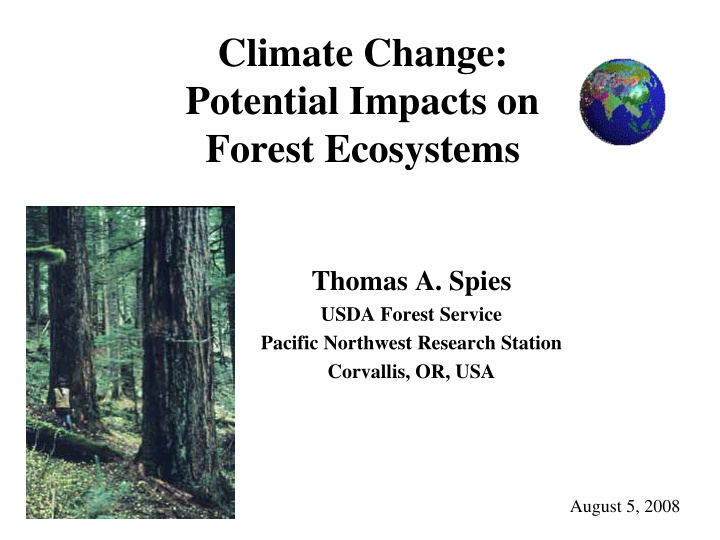



Climate Change: Potential Impacts on Forest Ecosystems Thomas A. Spies USDA Forest Service Pacific Northwest Research Station Corvallis, OR, USA August 5, 2008
Change in Mean Monthly Temperature (Degrees C) 2070-2099 vs 1961-1990 A1B B1 A2 MIROC HAD CSIRO R. Neilson
Percent Change in Precipitation 2070-2099 vs 1961-1990 A1B B1 A2 MIROC HAD CSIRO R. Neilson
Projections of Dynamic Global Vegetation Models Observed Simulated Historical R. Neilson
R. Neilson B1 A1B Historical A2 MIROC3_MEDRES HADCM3 CSIRO_MK3
A2 A1B B1 MIROC3_MEDRES HADCM3 CSIRO_MK3 percent Percent Change in Vegetation Carbon 2070-2099 vs. 1961-1990. R. Neilson
A2 A1B B1 MIROC3_MEDRES HADCM3 CSIRO_MK3 percent Percent Change Biomass consumed by Fire 2051-2100 vs. 1951-2000. R. Neilson
Types of Impacts • Direct – Ecosystem productivity – Tree growth – Establishment – Ecotone/range movement – Phenology • Indirect – Fire – Insects and Disease – Human responses (e.g. carbon sequestration)
Major Uncertainty • Increased CO 2 concentration can promote higher productivity through more efficient photosynthesis But • Warmer temperatures increase moisture stress and reduce photosynthesis But • But earlier start to growing season can boost growth during time when soil is relatively wet
Limits on vegetation net primary productivity 49 Studies: 37 Pos.; 5 Neg.; 7 no trend or mixed From Boisvenue and Running 2006
Examples of Ecological Changes
Upward Movement of Ecotones Shifts in Northern Hardwood/Boreal Forest Ecotone in Vermont Beckage et al. 2008. PNAS
Decline of High Elevation Meadows in the Oregon Coast Range Marys Peak Meadow Change (1948-1994) Meadow Increase (Road Related Disturbance) Meadow Decline (Forest Encroachment) Meadow No Change ~40% Decline in Meadow Vegetation at Marys Peak ~65% Decline in Summit Meadow Extent Throughout Oregon Coast Range Since 1948 Zald (in revision) Plant Ecology
Flowering Times Become Earlier And Species that Don’t Change in Flowering Time may Disappear Changes in mean first flowering dates for 43 plant species around Thoreau’s Concord, MA Rushing and Primack 2008
Shifts in Plant Species in Mountains Vary with Life History Shifts for in Optimum Elevation For Plant Species of French Alps in relation to life history: 1905-2005 Lenoir et al. 2008
Increased Mortality Mature Forests from Stress and Biotic Causes Changes in Tree Mortality in Old-growth Conifer Forests in the Sierra Nevada From Stephenson et al. 2007
Interactions of Climate and Disturbance: Mountain Pine Beetle Outbreak Kurz et al. 2008. Nature
Increasing Occurrence of Wildfires in Western US Westerling et. al. 2006
Monitoring 0 % 0 % Old Forest Loss to 0 % 3.6 % Wildfire 1993-2003 0 % 14 % ( incl B & B) 1.4 % 9.5 % 3 % Percent Loss of Older 2.3 % Forest on a Decadal Basis By Province 0.4 % Moeur and Spies et al. 2005
Potential Changes in Western Oregon • Tree lines move upward, loss of subalpine meadows • More fire, especially southern areas and valley margins • Earlier flowering and leaf out • Higher stress/mortality on dry sites • Species range shifts upwards and northwards • More insect and disease occurrence • Higher productivity on relatively moist sites
Implications to Conservation • Change—good or bad? • Uncertainty—keep options open • Complexity of responses—holistic/multi- scale perspective
Implications to Conservation • Potential vegetation types and historical range of variation (coarse filter approaches) less useful • Monitoring--targeted • Manage to increase resistance/resilience – Density management – Assisted colonization • Integrated approaches are necessary
Recommend
More recommend